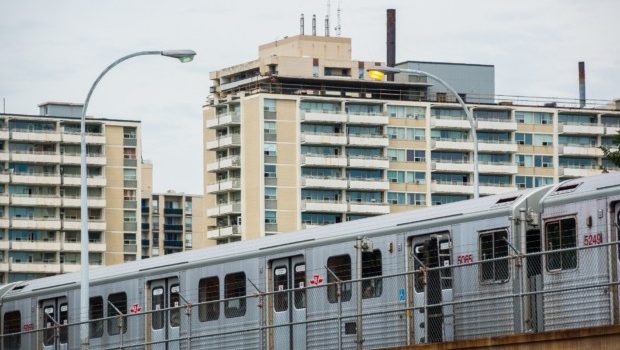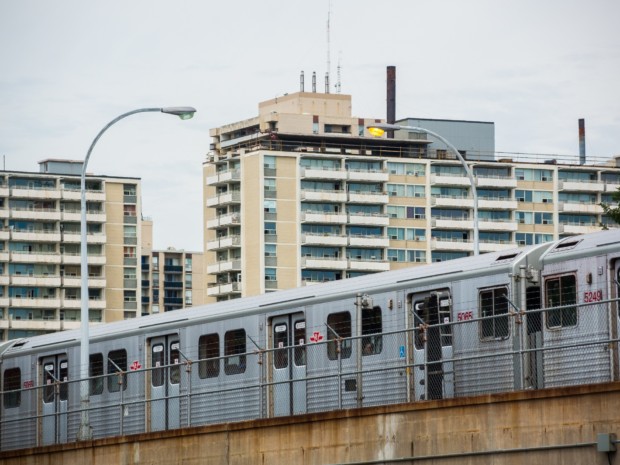


By Ryan Hanna
It’s an occurrence that happens regularly on Toronto’s subway lines — the dreaded “… is delayed due to signal issues” message over the PA system.
“The TTC has been making major strides in replacing its ancient signalling system. But it is a large job and the funding is scarce, meaning it is happening years later than it should have,” explains Cameron MacLeod, the executive director of CodeRedTO, a transit advocacy group. Line 2, he explains, requires new trains and upgraded signals before it can be extended into Scarborough.
To make matters worse, ever since the 1995 Russell Hill accident, the TTC requires two blocks ahead of the current train to be empty. The incident was caused because subway operators were, at the time, required to remember the previous signal and that the trigger that trips the emergency brake wasn’t engineered to actually pull the train’s brake. Though the issues were fixed afterwards, many aspects of the system are still failing or aging, and upgrades” cannot all occur during the normal maintenance window afforded the TTC each night when subway service ends,” the TTC explains on its website.
With the number of trains per hour throughout the system being limited, Line 1 is regularly overcapacity during the morning and evening peak periods. The installation of Automatic Train Control, or ATC, will help relieve pressure on the crowded Bloor-Yonge interchange. But the relief line, which would bring much-needed help to the system, is still more than a decade away (and preliminary design work is just starting now).
“The system remains a very simple two-line system, which is quite vulnerable to disruptions. We need more complexity: more lines, and more interchanges, so that riders have alternate routes. Until that exists, even small delays will still have a large impact,” says MacLeod.
“We’re working to implement ATC on Line 1 by 2021, but we don’t have a timeline for other lines yet,” says Hayley Waldman, spokesperson for the TTC.
The TTC is a complex network, made up of different signalling systems. Line 1 from Vaughan to Dupont (and the Eglinton Crosstown) uses communications-based train control. Line 2 along Bloor is stuck with the fixed-block system. Line 3 Scarborough uses a technology called transmission-based train control, which is the primary technology used throughout the system. Though it’s still safe, it’s become outdated — the busy Yonge-University line is slowly being upgraded to the newer ATC system, which will allow for more trains to run and at closer frequencies.
For most people, it’s difficult to understand what the complex issue of signal delays means. Here’s an explainer of what all these various terms mean:
Fixed-block
The portion of Line 1 stretching from Dupont to Finch, plus Line 2 and Line 4 Sheppard, all use the fixed-block signalling system, which is used in other major systems including the New York Subway, Chicago “L” and Boston “T”.
Within this system there are two different types of signals: block signals, which are used to keep trains spaced evenly apart and are controlled by the trains themselves; and interlocking signals, which control movement of trains in conflicting points, such as crossovers and sidings.
Lines covered by this system are split up into blocks, each of which is protected by a signal. There’s a mechanism to trip the emergency brakes if the operator disobeys the signal; and the system requires a gap of two empty blocks between trains, giving them ample room to brake (but reducing the number of trains that can run).
Select stations have timing devices that allow for trains to be spaced evenly apart, which work by determining whether a train is running fast (too close to the train before it) or slow (too close the train behind it) and then determining from this whether to hold the train in the station or not.
Transmission-based
Scarborough’s Line 3 uses SelTrac, a high-tech system that was originally part of the Urban Transportation Development Corporation — a provincial organization from the 70s and 80s that was supposed to create an electrified GO Train network, called GO-Urban. The SelTrac system is the same one used on Vancouver’s SkyTrain and the Detroit People Mover and allows trains to drive themselves, though due to union complaints, Toronto always has an attendant on each train.
Automatic train control
The TTC is slowly implementing the French train manufacturer Alstom’s newer and more advance electronic system on Line 1, which can result “in an average 30% higher capacity, whether on manned services or unattended train operation,” the company boasts. Installation began in December 2017, built right into the Vaughan extension, and will be enabled in the underground portion of the Eglinton Crosstown when it opens.
The main issue with ATC is that installation is intrusive and requires a lot of equipment to be installed on both the trains and tracks, all so that they can communicate with each other, send info to a control centre and receive instructions. Track-level beacons send signals to onboard computers, while roof-mounted antennas send the train’s speed and location to Transit Control which, in turn, interprets the status of the train and determines whether it should speed up, slow down, or keep its speed.
ATC allows for a much higher number of trains to pass through stations per hour — The Globe and Mail reports that Line 1 can achieve 25.5 trains per hour now and has reached 29 tph , but with ATC, achieving more than 30 trains per hour will become the new norm.
Signal delays
There are numerous reasons a signal issue could occur, many of which are because the fixed-block system wasn’t built to accommodate Toronto’s surge in riders over the last 50 years.
A “track down” is one culprit. It occurs when a block receives a false reading and thinks there is a train in the area when in reality, there isn’t. There are three ways to fix this:
- A “call-on” from transit control, where the trip arm is released and the signal blinks orange, but remains red
- Use a plunger to drop the trip arm and then move the train forward
- Perform a “trip through,” where the operator goes at a slow speed through the signal, tripping the emergency brake, before resetting it and continuing on
When signal issues do happen, it’s easy for trains to become delayed because of the ripple effect. When one train is delayed, the next one is too and so on, causing the initial ones to spend more time in the station and pick up more passengers. Trains behind them, meanwhile, remain relatively empty and cannot speed to the front of the delay because, unlike New York, we have only two tracks per line.
“We don’t specifically have one person who goes and fixes signal issues. Since the issue varies from situation to situation, so does the person who is able to fix it,” Waldman explains.
In a nutshell, the important thing to remember is delays generally happen because of all the moving parts that make up the traditional signalling systems. Once ATC is implemented systemwide, and computers are controlling the signals, this should cease to be an issue.
